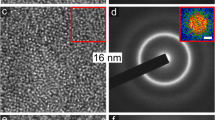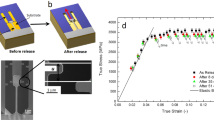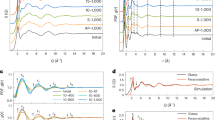Abstract
Fracture of nanoporous thin-film glasses is a significant challenge for the integration of these mechanically fragile materials in emerging microelectronic and biological technologies. In particular, the integration of these materials has been limited by accelerated cracking rates in moist environments leading to premature failure. Here, we demonstrate how cracking is affected by aqueous solution chemistry, and reveal anomalously high crack-growth rates in hydrogen peroxide solutions frequently encountered during device processing or when in use. Kinetic mechanisms involving the transport and steric hindrance of reactive hydrogen peroxide molecules at the crack tip are proposed. Thin-film design strategies that involve energy dissipation by local plasticity in thin ductile layers on increasing the resistance to cracking of nanoporous glass layers is demonstrated. Understanding how aqueous solutions influence cracking and associated device reliability is a fundamental challenge for these promising materials to be viable candidates for new technologies.
This is a preview of subscription content, access via your institution
Access options
Subscribe to this journal
Receive 12 print issues and online access
$259.00 per year
only $21.58 per issue
Buy this article
- Purchase on Springer Link
- Instant access to full article PDF
Prices may be subject to local taxes which are calculated during checkout





Similar content being viewed by others
References
Hedrick, J. et al. Templating nanoporosity in thin-film dielectric insulators. Adv. Mater. 10, 1049–1053 (1998).
Desai, T., Hansford, D., Leoni, L., Essenpreis, M. & Ferrari, M. Nanoporous anti-fouling silicon membranes for biosensor applications. Biosens. Bioelectron. 15, 453–462 (2000).
Dabrowski, A. Adsorption - from theory to practice. Adv. Colloid Interface Sci. 93, 135–224 (2001).
Nguyen, C. et al. Low-dielectric, nanoporous organosilicate films prepared via inorganic/organic polymer hybrid templates. Chem. Mater. 11, 3080–3085 (1999).
Nguyen, C. et al. Hyperbranched polyesters as nanoporosity templating agents for organosilicates. Macromolecules 33, 4281–4284 (2000).
Lane, M.W., Snodgrass, J.M. & Dauskardt, R.H. Environmental effects on interfacial adhesion. Microelectron. Reliab. 41, 1615–1624 (2001).
Lane, M., Dauskardt, R.H., Krishna, N. & Hashim, I. Adhesion and reliability of copper interconnects with Ta and TaN barrier layers. J. Mater. Res. 15, 203–211 (2000).
Dauskardt, R.H., Lane, M., Ma, Q. & Krishna, N. Adhesion and debonding of multi-layer thin film structures. Eng. Fract. Mech. 61, 141–162 (1998).
Cook, R. & Liniger, E. Stress-corrosion cracking of low-dielectric-constant spin-on-glass thin films. J. Electrochem. Soc. 146, 4439–4448 (1999).
Wiederhorn, S.M. Influence of water vapor on crack propagation in soda-lime glass. J. Am. Ceram. Soc. 50, 407–414 (1967).
Wiederhorn, S.M. & Bolz, L.H. Stress corrosion and static fatigue of glass. J. Am. Ceram. Soc. 53, 543–548 (1970).
Hillig, W.B. & Charles, R.J. in Proceedings of the Second Berkeley International Materials Conference (ed. Zackey, V.F.) 682–705 (Wiley, Univ. California, Berkeley, 1965).
Wiederhorn, S.M. A chemical interpretation of static fatigue. J. Am. Ceram. Soc. 55, 81–85 (1972).
Michalske, T.A. & Freiman, S.W. A molecular interpretation of stress corrosion in silica. Nature 295, 511–512 (1982).
Bhatnagar, A., Hoffman, M.J. & Dauskardt, R.H. Fracture and subcritical crack-growth behavior of Y-Si-Al-O-N glasses and Si3N4 ceramics. J. Am. Ceram. Soc. 83, 585–596 (2000).
Dill, S.J., Bennison, S.J. & Dauskardt, R.H. Subcritical crack-growth behavior of borosilicate glass under cyclic loads: Evidence of a mechanical fatigue effect. J. Am. Ceram. Soc. 80, 773–776 (1997).
Crichton, S.N., Tomozawa, M., Hayden, J.S., Suratwala, T.I. & Campbell, J.H. Subcritical crack growth in a phosphate laser glass. J. Am. Ceram. Soc. 82, 3097–3104 (1999).
Wiederhorn, S.M., Johnson, H., Heuer, A.H. & Diness, A.M. Fracture of glass in vacuum. Am. Ceram. Soc. Bull. 52, 336–341 (1973).
Cook, R.F. & Liniger, E.G. Kinetics of indentation cracking in glass. J. Am. Ceram. Soc. 76, 1096–1105 (1993).
Michalske, T.A. & Bunker, B.C. A chemical kinetics model for glass fracture. J. Am. Ceram. Soc. 76, 2613–2618 (1993).
Williams, J.G. & Marshall, G.P. Environmental crack and craze growth phenomena in polymers. Proc. R. Soc. Lond. A 342, 55–77 (1975).
Chan, M.K.V. & Williams, J.G. Slow stable crack-growth in high-density polyethylenes. Polymer 24, 234–244 (1983).
Lane, M. et al. in Materials Reliability in Microelectronics VII Symposium (eds Clement, J. J., Keller, R. R., Krisch, K. S., Sanchez, J. E. Jr, & Suo, Z.) 21–26 (Materials Research Society, San Francisco, California, 1997).
Snodgrass, J.M., Pantelidis, D., Jenkins, M.L., Bravman, J.C. & Dauskardt, R.H. Subcritical debonding of polymer/silica interfaces under monotonic and cyclic loading. Acta Mater. 50, 2395–2411 (2002).
Kook, S.Y. & Dauskardt, R.H. Moisture-assisted subcritical debonding of a polymer/metal interface. J. Appl. Phys. 91, 1293–1303 (2002).
Lane, M., Dauskardt, R.H., Vainchtein, A. & Gao, H. Plasticity contributions to interface adhesion in thin-film interconnect structures. J. Mater. Res. 15, 2758–2769 (2000).
Wiederhorn, S.M., Freiman, S.W., Fuller, E.R. Jr & Simmons, C.J. Effects of water and other dielectrics on crack growth. J. Mater. Sci. 17, 3460–3478 (1982).
Wiederhorn, S.M. & Johnson, H. Effect of electrolyte pH on crack propagation in glass. J. Am. Ceram. Soc. 56, 192–197 (1973).
White, G.S., Freiman, S.W., Weiderhorn, S.M. & Coyle, T.D. Effects of counterions on crack growth in vitreous silica. J. Am. Ceram. Soc. 70, 891–895 (1987).
Michalske, T.A. & Bunker, B.C. Steric effects in stress corrosion fracture of glass. J. Am. Ceram. Soc. 70, 780–784 (1987).
Bird, R.B., Stewart, W.E. & Lightfoot, E.N. Transport Phenomena (Wiley, New York, 2002).
Lane, M., Dauskardt, R., Qing, M., Fujimoto, H. & Krishna, N. in Materials Reliability in Microelectronics IX. Symposium 251–256 (Materials Research Society, San Francisco, California, 1999).
Wiederhorn, S.M., Fuller, E.R.J. & Thomson, R. Micromechanisms of crack growth in ceramics and glasses in corrosive environments. Met. Sci. 14, 450–458 (1980).
Tuckerman, M., Marx, D. & Parrinello, M. The nature and transport mechanism of hydrated hydroxide ions in aqueous solution. Nature 417, 925–929 (2002).
Kerr, J.A. Bond dissociation energies by kinetic methods. Chem. Rev. 66, 465–500 (1966).
Strohband, S. & Dauskardt, R.H. Interface separation in residually-stressed thin-film structures. Interface Sci. 11, 309–17 (2003).
Toivola, Y., Thurn, J. & Cook, R.F. Structural, electrical, and mechanical properties development during curing of low-k hydrogen silsesquioxane films. J. Electrochem. Soc. 149, F9–F17 (2002).
Acknowledgements
This work was supported in part by the Director, Office of Energy Research, Office of Basic Energy Sciences, Materials Sciences Division of the US Department of Energy, under Contract No. D3-FG03-95ER45543. Materials were supplied by JSR (Tsukuba, Ibaraki, Japan) and LETI (Grenoble, France) and the authors gratefully acknowledge the assistance of M. Patz (JSR) and S. Maitrejean (LETI).
Author information
Authors and Affiliations
Corresponding author
Ethics declarations
Competing interests
The authors declare no competing financial interests.
Rights and permissions
About this article
Cite this article
Guyer, E., Dauskardt, R. Fracture of nanoporous thin-film glasses. Nature Mater 3, 53–57 (2004). https://doi.org/10.1038/nmat1037
Received:
Accepted:
Published:
Issue Date:
DOI: https://doi.org/10.1038/nmat1037
This article is cited by
-
Peel-and-Stick: Mechanism Study for Efficient Fabrication of Flexible/Transparent Thin-film Electronics
Scientific Reports (2013)
-
Superior mechanical properties of dense and porous organic/inorganic hybrid thin films
Journal of Sol-Gel Science and Technology (2008)
-
Annealing-induced interfacial toughening using a molecular nanolayer
Nature (2007)
-
Time-dependant intercellular delamination of human stratum corneum
Journal of Materials Science (2007)
-
Controlling crack propagation
Nature Materials (2004)



